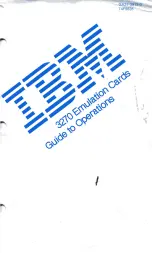
67
Some Common Uses of Trigger Scripts
•
Switch from Stereo to L+R Mono
•
Switch from L+R Mono to Stereo
•
Switch the Stereo Pilot off
•
Switch the Stereo Pilot back on and at 9% injection
•
Switch the Omnia's audio input source from Analog to Digital
•
Switch the Omnia's audio input from Digital to Analog
The Para, The Syspara, and Command Line Entries
What Is a “Para”?
In general*, a 'para' is a variable that corresponds to one of the adjustable controls available within a Processing
Block. For instance, the Wide Band AGC Release Time is a 'para', in fact, it happens to be 'para' 3.
What Is a “Syspara”?
In general*, a 'syspara' is a system parameter assigned to the basic operation of the “System”. Controls such as
the one for audio source selection, the mono operating mode, and the stereo pilot state and its injection level,
each have a “syspara” value associated with it. A complete list of Omnia-3fm Turbo 'syspara' values can be
found on Page 69.
* In the above explanation, we used the disclaimer “in general” because there are certain exceptions.
What About Command Line Entries?
Just as 'paras' and 'sysparas' can manipulate the processing controls and system adjustments, there are higher
level commands available which do even more special things. Later, we'll discuss how the command line can be
used to manipulate the Daypart Scheduler.
Using The Trigger Script Editor
A Trigger Script is “written” using the Trigger Interface Script Editor that is contained within the Omnia
Remote Control software. The Script Editor runs in a separate window from the Remote Control window. The
Editor window is opened under the Options menu (Edit Trigger Scripts). To open the Script Editor window, the
computer running the Remote Software must be connected to and communicating with the Omnia-3.
Starting the Script Editor (Options / Edit Trigger Scripts) opens up the Script Editor window. The eight radio
buttons along the left side select which trigger script number to display and edit. The top edit box shows the
script for the Trigger HIGH Command Script (contact open) for the selected input. The bottom edit box shows
the script for the Trigger LOW Command Script (contact closure) for that input.
Once a script has been entered, clicking the Test button checks the script syntax, and if correct, sends the
displayed script to the Omnia-3 for immediate execution. Use the command line window and/or any alert
dialogs that pop up to view the success or failure of the script. Note that executing the script in this manner does
not result in the script being downloaded or saved as a trigger script, it is simply run once to see if the script, as
written, actually works.
The buttons along the bottom of the window load, save, or download the current scripts being edited to the PC
Card. Click “Save to Card” to permanently store the current scripts on the PC Card in one file. Click “Load
from Card” to retrieve previously saved scripts. To download the scripts for use in the processor without saving
to the PC Card, click “Apply” if further script editing will be done. Click “OK” to download the current scripts
















































